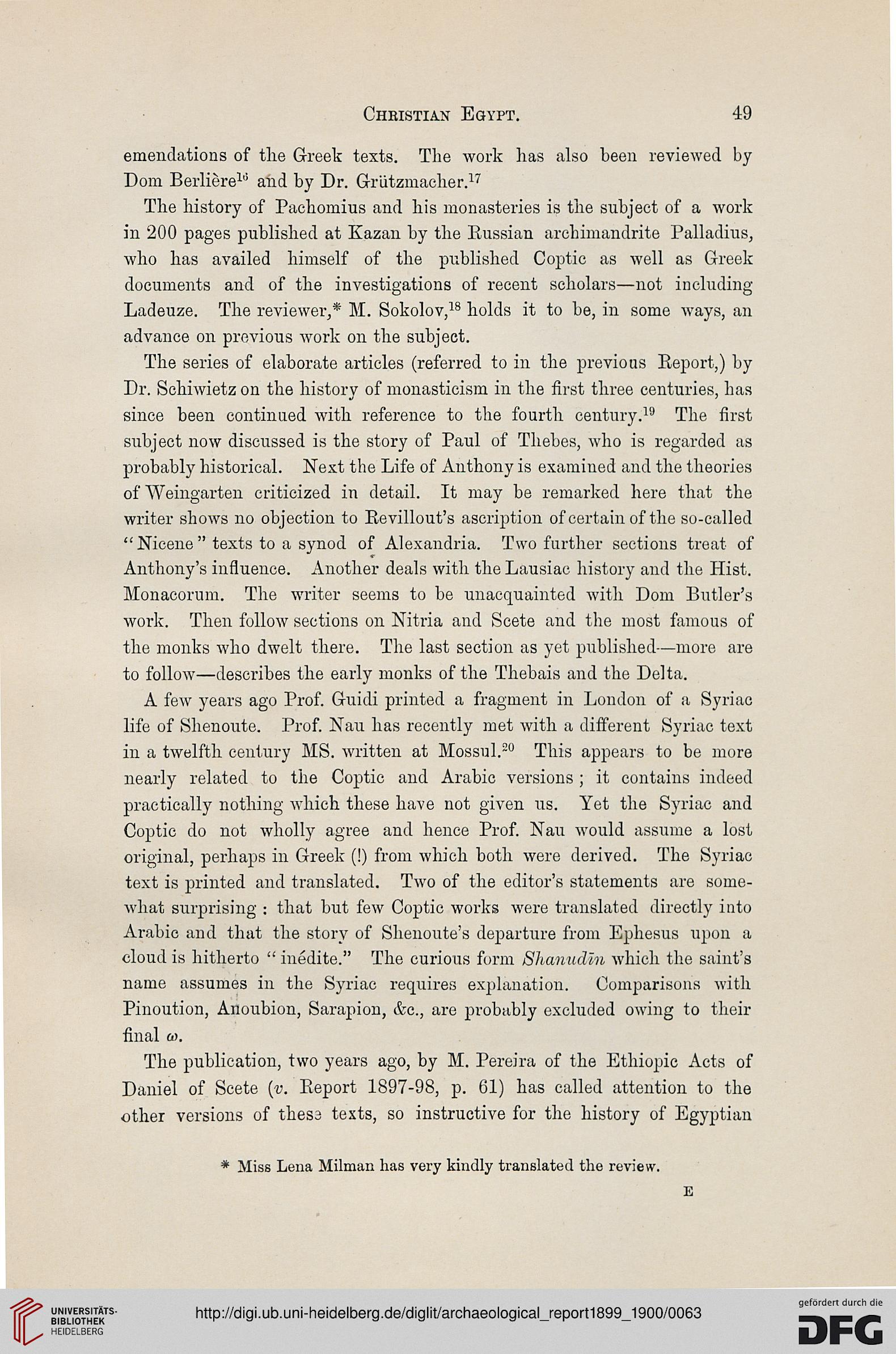Christian Egypt.
•19
emendations of the Greek texts. The work lias also been reviewed by
Dom Berliere10 and by Dr. Griitzmacher.17
The history of Pachomius and his monasteries is the subject of a work
in 200 pages published at Kazan by the Eussian archimandrite Palladius,
who has availed himself of the published Coptic as well as Greek
documents and of the investigations of recent scholars—not including
Ladeuze. The reviewer,* M. Sokolov,18 holds it to be, in some ways, an
advance on previous work on the subject.
The series of elaborate articles (referred to in the previous Eeport,) by
Dr. Schiwietz on the history of monasticism in the first three centuries, has
since been continued with reference to the fourth century.19 The first
subject now discussed is the story of Paul of Thebes, who is regarded as
probably historical. Next the Life of Anthony is examined and the theories
of Weingarten criticized in detail. It may be remarked here that the
writer shows no objection to Eevillout's ascription of certain of the so-called
" Nicene " texts to a synod of Alexandria. Two further sections treat of
Anthony's influence. Another deals with the Lausiac history and the Hist.
Monacornm. The writer seems to be unacquainted with Dom Butler's
work. Then follow sections on Nitria and Scete and the most famous of
the monks who dwelt there. The last section as yet published—more are
to follow—describes the early monks of the Thebais and the Delta.
A few years ago Prof. Guidi printed a fragment in London of a Syriac
life of Shenoute. Prof. Nau has recently met with a different Syriac text
in a twelfth century MS. written at Mossul.20 This appears to be more
nearly related to the Coptic and Arabic versions ; it contains indeed
practically nothing which these have not given us. Yet the Syriac and
Coptic do not wholly agree and hence Prof. Nau would assume a lost
original, perhaps in Greek (!) from which both were derived. The Syriac
text is printed and translated. Two of the editor's statements are some-
what surprising : that but few Coptic works were translated directly into
Arabic and that the story of Shenoute's departure from Ephesus upon a
cloud is hitherto " inedite." The curious form Shanudin which the saint's
name assumes in the Syriac requires explanation. Comparisons with
Pinoution, Anoubion, Sarapion, &c, are probably excluded owing to their
final &).
The publication, two years ago, by M. Pereira of the Ethiopia Acts of
Daniel of Scete (v. Eeport 1897-98, p. 61) has called attention to the
other versions of these texts, so instructive for the history of Egyptian
* Miss Lena Milman has very kindly translated the review.
e
•19
emendations of the Greek texts. The work lias also been reviewed by
Dom Berliere10 and by Dr. Griitzmacher.17
The history of Pachomius and his monasteries is the subject of a work
in 200 pages published at Kazan by the Eussian archimandrite Palladius,
who has availed himself of the published Coptic as well as Greek
documents and of the investigations of recent scholars—not including
Ladeuze. The reviewer,* M. Sokolov,18 holds it to be, in some ways, an
advance on previous work on the subject.
The series of elaborate articles (referred to in the previous Eeport,) by
Dr. Schiwietz on the history of monasticism in the first three centuries, has
since been continued with reference to the fourth century.19 The first
subject now discussed is the story of Paul of Thebes, who is regarded as
probably historical. Next the Life of Anthony is examined and the theories
of Weingarten criticized in detail. It may be remarked here that the
writer shows no objection to Eevillout's ascription of certain of the so-called
" Nicene " texts to a synod of Alexandria. Two further sections treat of
Anthony's influence. Another deals with the Lausiac history and the Hist.
Monacornm. The writer seems to be unacquainted with Dom Butler's
work. Then follow sections on Nitria and Scete and the most famous of
the monks who dwelt there. The last section as yet published—more are
to follow—describes the early monks of the Thebais and the Delta.
A few years ago Prof. Guidi printed a fragment in London of a Syriac
life of Shenoute. Prof. Nau has recently met with a different Syriac text
in a twelfth century MS. written at Mossul.20 This appears to be more
nearly related to the Coptic and Arabic versions ; it contains indeed
practically nothing which these have not given us. Yet the Syriac and
Coptic do not wholly agree and hence Prof. Nau would assume a lost
original, perhaps in Greek (!) from which both were derived. The Syriac
text is printed and translated. Two of the editor's statements are some-
what surprising : that but few Coptic works were translated directly into
Arabic and that the story of Shenoute's departure from Ephesus upon a
cloud is hitherto " inedite." The curious form Shanudin which the saint's
name assumes in the Syriac requires explanation. Comparisons with
Pinoution, Anoubion, Sarapion, &c, are probably excluded owing to their
final &).
The publication, two years ago, by M. Pereira of the Ethiopia Acts of
Daniel of Scete (v. Eeport 1897-98, p. 61) has called attention to the
other versions of these texts, so instructive for the history of Egyptian
* Miss Lena Milman has very kindly translated the review.
e





